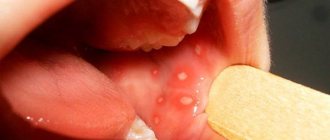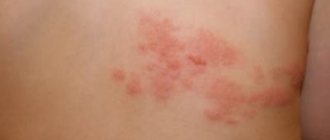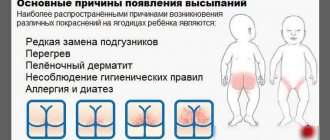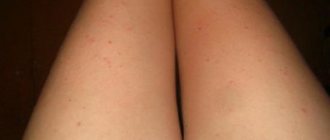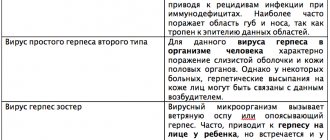Hemorrhagic rash can be the cause of various diseases. It occurs as a result of capillaries rupturing and red blood cells leaking out of the vessels. Most often, the rashes do not rise above the surface of the skin and cannot be felt. The exception is inflammation of the capillary walls.
Such pathology can be expressed in a variety of forms, each of which has certain distinctive features. If any rash occurs, you should immediately consult a doctor, who will determine the underlying cause and prescribe the correct treatment.
Features of the rash
A hemorrhagic rash, a photo of which is in the article, refers to the formation of small non-inflammatory rashes on the skin of different parts of the body. This is how the body reacts to the rupture of capillaries, the subsequent penetration of red blood cells into the upper layers of the skin.
When it appears, a person does not experience any discomfort at all, since the rash does not itch and does not cause pain. When pressing on the affected area, the color of the rash does not change. The number of points largely depends on the cause of the lesion and the severity.
In a child under 5 years of age, the disease can be triggered by vascular pathologies, and in a child from 5 to 15 years old - by colds and infectious diseases. In addition, the hereditary factor is important.
Hemorrhagic vasculitis: treatment, symptoms, photos, causes
Photos of hemorrhagic spots on the legs and other parts of the body make it possible to see with your own eyes the signs of such a common pathology. The first symptom of the defect is small hemorrhages that resemble miniature bruises. They can be found on the bends of the limbs, feet, palms and joints. In some situations, the rash covers the face. They can spread throughout the body.
Most often, hemorrhagic spots appear on the legs, which makes diagnosis much more complicated. After all, this symptom is characteristic of many pathologies.
Another important symptom is joint damage. This symptom appears in most cases of the disease. As a rule, the lesion covers the ankle or knee joint. In this case, the patient may be bothered by pain that occurs periodically. In some situations, an inflammatory process begins.
Visual signs of the disease can be seen in the photo of hemorrhagic spots.
The pathology is also characterized by sharp pain in the abdominal area. These symptoms may be accompanied by other manifestations:
- nausea;
- diarrhea;
- vomit;
- elevated body temperature.
Some patients develop internal bleeding.
This disease, medically called Henoch-Schönlein syndrome or allergic (rheumatic) purpura, is diagnosed mainly in patients aged 5-13 years. In adults, cases of hemorrhagic vasculitis are also common.
It occurs less frequently in children under 3 years of age. The development of this disease is always associated with damage to the walls of vascular beds, an increase in the degree of their permeability, activation of the protein metabolism process, and increased production of immune responses.
Hemorrhagic vasculitis is a systemic disease of a series of vasculitis, characterized by damage to the walls of the smallest vessels of the body - capillaries, venules and arterioles. This condition is always accompanied by a violation of the structure of these blood vessels.
As a rule, the disease occurs with the presence of aseptic inflammation, which significantly increases the likelihood of blood clots. In the presence of rheumatic purpura, not only the blood vessels of the skin are affected, but also the internal organs (joints, kidneys, gastrointestinal tract).
Causes of hemorrhagic vasculitis
The main trigger of this disease is infection of various etiologies. These could be fungi, bacteria or viruses. The development of the disease is also influenced by the use of certain medications and the unfavorable environmental conditions in which the patient lives.
Predisposing factors to the occurrence of hemorrhagic vasculitis are:
- insect bites;
- thermal burns;
- injuries of various origins;
- intoxication due to biological poisons entering the body;
- vaccination procedures;
- congenital functional disorders of the immune system;
- colds;
- overheating or hypothermia of the body;
- allergic reactions caused by food agents.
Hemorrhagic rash can be expressed in the form of various rashes, from small dots to large spots. The color also varies and can be red, purple, lilac and even black. The shape of the elements of the rash, depending on the disease that caused it, is different.
You can see what disease causes a red spot on a child’s face in another article.
The smallest rash is always in the form of dots, but there may also be large spots of 5 mm (sometimes more) in the form of blots, splashes, and stars. The rash is usually not accompanied by itching, but a number of additional symptoms may occur, depending on what disease caused the rash.
Classification
According to the nature of the spread, hemorrhagic rash is divided into primary and secondary. Primary is characterized by the fact that spots form on clean skin. It is divided into cavity and cavityless. The secondary form is a consequence of the development of elements of the primary rash.
According to its appearance and size, the hemorrhagic rash, a photo of which shows the features of the disorder, is divided into:
- petechiae;
- purples;
- ecchymoses.
Petechiae are small round spots. Their shade can vary from bright red to dark brown. When an insect bites, the middle of the petechia takes on a brighter shade when compared with the rest of the surface.
Purpura is a subcutaneous spot, the diameter of which is 2-5 mm, but sometimes it can be 1 cm. Often the spots merge with each other, forming one large one. May also be accompanied by burning and itching. The rash is localized on the arms, stomach, and legs. It has a purple tint, but in some cases changes to dark red or even brown.
Ecchymoses are the largest hemorrhagic rash. It consists of shapeless spots, the diameter of which ranges from 5 mm to several centimeters. Their shade can range from pink to blue-black. Elements of the rash can connect with each other, forming a large affected area, with necrotic elements in the center.
If the pathological process develops severely, then tissue necrosis can spread even further, causing rejection of a large area of skin. This can lead to gangrene.
Causes of hemorrhagic rash
A hemorrhagic rash is not that uncommon; its causes are many diseases of infectious or immunocomplex origin.
In the occurrence of a hemorrhagic rash of immunocomplex origin, the leading role is played by the interaction of antigen and antibody, which leads to the formation of circulating immune complexes. The causes of the formation of CEC can be burns, vaccinations, viruses, bacteria, hypothermia, medications, etc. An example of a disease accompanied by a hemorrhagic rash of this origin is hemorrhagic vasculitis.
The resulting CECs “storm” the endothelium of small vessels. After such exposure, aseptic inflammation develops in the vascular wall, i.e. inflammation of non-infectious origin. The body directs leukocytes to fight the CEC, releasing free oxygen radicals; macrophages brought into an active state; lysosomal enzymes; interleukins six and eight. All these activated factors cause damage to the vascular wall with the formation of areas of necrosis and edema around the vessels.
Damage to the vascular wall activates the hemostasis system. The hemostasis system activates platelet adhesion, hypercoagulation, and an increase in von Willebrand factor (its synthesis occurs mainly in the vascular wall, so it reflects the severity of endothelial damage). All this leads to the release of blood cells from the bloodstream, the formation of microthrombi and hemorrhagic skin rash - this is the result of a catastrophe occurring in the body.
With the development of a hemorrhagic rash of infectious origin, the pathogenetic picture is somewhat different.
In infectious diseases, for example, in the generalized form of meningitis (meningococcemia), a hemorrhagic rash on the skin appears due to the action of pathogen toxins on the capillaries, which disrupts peripheral hemodynamics. Hypercoagulation develops and elements of a hemorrhagic rash appear on the skin.
In both the first and second cases, a hemorrhagic rash develops not only on the skin, similar changes occur in the internal organs, which complements the picture of a hemorrhagic rash in a particular disease.
Causes
The causes of hemorrhagic rash can be very different. It occurs at any age, regardless of gender. In adults, this condition is accompanied by liver damage. This may be due to:
- chemicals;
- alcoholic drinks;
- viruses;
- injuries;
- medications;
- junk food.
When the liver is damaged, the ability to clot blood is impaired. The cause of the rash may be a genetic predisposition. Hemophilia, a chronic bleeding disorder, is often identified among genetic diseases.
A hemorrhagic rash can be infectious. In this case, it is provoked by:
- meningococcus;
- scarlet fever;
- tick bites.
With an immunocomplex origin of the disorder, there are many different provoking factors. That is why a rash can occur against the background of a bacterial infection, a virus, a burn, vaccinations, hypothermia, or the use of certain medications.
The exact cause of rashes is not always determined. In this case, diagnosis and treatment should be carried out by qualified specialists.
Hemorrhagic rash on the legs of an adult: causes, spots
In many cases, a person develops a hemorrhagic rash on the legs. Hemorrhagic vasculitis in medicine is called Henoch-Schönlein disease. The pathology is accompanied by disruption of the structures of blood vessels.
Are you having any problem? Enter “Symptom” or “Name of the disease” into the form, press Enter and you will find out all the treatment for this problem or disease. The site provides reference information.
Adequate diagnosis and treatment of the disease is possible under the supervision of a conscientious doctor. Any medications have contraindications.
Consultation with a specialist is required, as well as detailed study of the instructions! Here you can make an appointment with a doctor.
Why does a hemorrhagic rash appear on the legs?
A rash on the legs is a modification of the skin, accompanied by some symptoms, caused by rupture of blood capillaries. If you lightly press on the skin of your legs covered with a rash, it will not even turn pale.
In appearance, the hemorrhagic rash consists of spots of multifaceted shades: from soft lilac to dark purple.
Thin stripes of black and blue colors may occur. Small formations have a “nickname” - “petechiae”, larger spots are called “ecchymosis”.
In medical practice, various diseases of immunocomplex and infectious origin will cause hemorrhages on the legs of an adult.
The appearance of hemorrhagic rashes of immunocomplex origin provokes interaction between antibodies and antigens, which leads to the appearance of a CIC (circulating immune complex).
Provoking factors for the rapid development of hemorrhagic vasculitis:
- Genetic predisposition. Hemorrhages of red, violet, lilac, lilac colors occur on the lower extremities due to poor heredity. For example, hemophilia, accompanied by subcutaneous hematomas, the violation of which leads to external and internal bleeding, cannot be excluded.
- An infectious disease is a sure harbinger that the development of pathology has already begun. More often, hemorrhagic spots appear due to scarlet fever, meningococcal infection or tick bites.
- Pathological inflammation of the skin and blood vessels.
- Injuries of various origins.
- Malfunctions of the immune system.
- Thermal burns of varying degrees of intensity.
- Prolonged stay in the cold or under scorching sun rays.
- Intoxication of the body caused by the penetration of biological poisons into the body.
- Colds: sore throat, flu.
- An allergic reaction caused by the active influence of food agents.
Features of the development of the disease with influenza
In medical practice, the number of hemorrhagic rashes on the legs has increased, and this greatly complicates the diagnosis of pathology.
A rash can appear due to hereditary and infectious diseases, which lead to vascular damage.
In medical practice, cases of vasculitis affecting children in the age group from 4 to 12 years have been recorded. Older people also tend to get sick.
The risk of contracting vasculitis increases significantly when a child has had the flu, ARVI, food allergies, or has been vaccinated.
Intensely colored bruises on the skin clearly demonstrate the presence of a serious pathology in the baby, which should be a reason for immediate contact with a hospital.
Vasculitis should not interfere with your life, which means you must immediately begin to identify the causes of the disease and their subsequent elimination.
The disease appears due to serious factors, for example, von Willebrand disease or hemophilia - a purely male pathology in which intense bleeding does not stop and blood clotting is impaired.
More often, the epidermis on the legs becomes covered with unattractive spots due to:
- Unfavorable heredity.
- Hormone abuse.
- The presence of pathologies of an infectious nature.
- Taking steroid drugs.
- Pathological changes in blood vessels.
First, a patient diagnosed with a hemorrhagic rash needs emergency medical attention.
Before the medical staff arrives, provide the patient with comfortable home conditions: give him warm sweet tea, give him an antipyretic, apply something cold to his head.
The patient spends most of his time in bed, without leaving for long. Antihistamines will ease the course of the disease; in more severe cases, take corticosteroids, the course of treatment of which can vary between 4-8 weeks.
During an exacerbation, it is advised to enrich your body with medications aimed at tightening blood vessels and giving them elasticity.
Discover skin free from itching and aesthetic defects with such preparations as “Calcium Chloride”, “Rutin”, “Ascorbic Acid”.
Rashes due to hemorrhagic vasculitis
The pathology is dangerous not so much because small bluish spots appear during it, but because the problem causes a lot of discomfort and pain. During the time interval when the rash disappears, pigmentation appears, accompanied by obvious peeling.
The disease is characterized by joint damage. The patient may complain of short-term pain.
It is important to choose a comprehensive treatment that would selectively influence the cause of the disease and the mechanism of its development.
Therapeutic complexes are based on symptomatic treatment and timely provision of assistance in the emerging situation.
The clinical picture of vasculitis may be complicated by the manifestation of orthostatic purpura.
Principles of rash treatment:
https://feedmed.ru/uhod/problemy/gemorragicheskaya-syp-nogah.html
- Strict restriction of physical activity. Try not to make sudden impulsive movements or turns if the medical history is dominated by abdominal and skin syndrome.
- If, along with vasculitis, another disease predominates in the patient, for example, chronic inflammation in the nasopharynx, tonsils, then it is necessary to urgently begin to eliminate them.
- Persons with Henoch-Schönlein disease should beware of vaccination with products containing bacterial particles (Mantoux test).
- If vasculitis is accompanied by damage to the skin, then the patient needs to take sulfonamide drugs, which prevents cell division.
- In the presence of massive gastrointestinal lesions with complications in the form of intense pain in the epigastric region, a course of corticosteroids is recommended. Hormone therapy consists of intravenous drip administration of drugs, then the person switches to tablet form.
- Taking a mix of cytostatics and glucocorticosteroids. High doses of such drugs must be taken if the patient is prone to severe kidney damage.
Causes of star shape
The development of pathological changes in the skin is associated with damage to the elastic walls of the vascular bed, their permeability increases, and protein metabolism processes are actively launched.
A hemorrhagic rash stands out against the background of healthy areas of skin. It looks like it is soaked in burgundy blood, and this is explained by the rupture of blood capillaries.
Often there is so much rash that it spreads throughout the body: arms, thighs, buttocks and even legs. The rash has a “star” shape, and in appearance it can be compared to ink splatters.
The rash caused by scarlet fever most often appears in the area of the popliteal folds, in the neck and elbows. Patients with sepsis also often develop hemorrhagic rashes.
Skin pathology during meningitis
Due to meningitis, a severe inflammation of the soft membranes of the spinal cord and brain, hemorrhages often appear.
Meningitis can occur on its own, out of nowhere, or due to other diseases.
With meningitis, the patient feels:
- Nausea, urge to vomit.
- Rapid increase in body temperature, fever, sweating.
- Fear of light and sound.
- Stiffness of the neck muscles.
The rash with meningitis is hemorrhagic, looks like pink spots, and after a while turns into large red hemorrhages.
As the disease progresses, the spots may take on different shades and become darker.
More often, hemorrhagic spots appear due to:
- Transferred rubella.
- Scarlet fever.
- Corey.
Treatment of bright red, violet, lilac rashes, which are accompanied by alarming signals, requires urgent consultation with a doctor.
In the standard case, the patient is advised to strictly adhere to bed rest and not skip taking antibiotics.
If meningitis, accompanied by hemorrhagic rashes, smoothly progresses into the chronic stage, then resuscitation procedures will be useful in treatment.
Formations appeared on the hands
There are many types of hemorrhagic rashes, but more often unattractive spots appear on the arms and in the elbow area. It’s unpleasant when the skin of your hands becomes stained in the summer - you have to shyly hide all your beauty under clothes.
A hemorrhagic rash usually appears after an infectious disease, after contact with some allergen. An integrated approach is important here.
If your life is already broken into millions of pieces and you cannot improve your health, then antihistamines will come to your rescue.
Manifestation of the disease on the face of an adult
Your face is your business card, a ticket to a good life. It is important not to be lazy and always keep it in good condition.
All kinds of spots that appear on the face over and over again cause psychological suffering, make one’s mood more gloomy, and make one fall into depression.
This applies to teenage children with skin covered with unattractive spots. Children of the same age may make fun of such a child, and this is oh, how unpleasant.
To make your going out perfect, use time-tested remedies for hemorrhagic spots on your face.
Healers of past centuries knew that the following golden recipe helps to maintain the tenderness, elasticity and velvety of the skin: make a healing mixture from horsetail herbs, peppermint sprigs and black elderberry leaves.
Take a few tablespoons of the mixture and pour boiling water over them. Everything is ready, in front of you is a decoction a la a miracle cure for hemorrhagic vasculitis. Regularly make phytoapplications from the decoction, applying them to the disease-affected areas.
Help from folk remedies
Nature gives us everything. The remedies used by people based on natural ingredients are life-affirming proof that it is worth looking for salvation from illnesses in natural resources.
Our great-grandfathers and great-grandmothers successfully treated hemorrhagic rashes with the help of golden traditional medicine.
There is no great loss if you use forest gifts to prepare such products.
Using cosmetic products will cause a serious dent in your budget, so decide which is best.
- Garlic oil is a real elixir of youth, a doctor that saves you from many diseases. Traditional medicine strongly advises its use in the fight against unwanted rashes.
- Legendary recipe from Vanga. The seer believed that a bath made from oak bark decoction would improve overall health and remove pathology – hemorrhagic vasculitis.
- To make your skin shine with beauty, boil barley grains in a large pan of water. We warn you - barley grains are sold in any pharmacy.
Possible consequences and complications
Hemorrhagic vasculitis proceeds without a trace, leaving no bad “stains” on a person’s “hospital reputation.” In case of untimely, and most importantly illiterate treatment, the prognosis is unfavorable.
And it faces the following complications:
- Pulmonary hemorrhages;
- Formation of hemorrhagic diathesis;
- Peritonitis;
- Interference with the functioning of the liver and heart;
- Chronic renal failure;
- Intestinal obstruction.
Doctor: Olga Shishkina ✓ Article checked by doctor
Main symptoms
The hemorrhagic rash itself is not the only symptom. With each type of disease, the spots have their own characteristics. One of them is hemosiderosis. The rashes merge into one common hematoma and acquire a reddish tint. Such a disorder can be provoked by the destruction of red blood cells outside the vessels, during which iron-containing pigment begins to be released.
With liver problems, toxic substances accumulate, which provokes severe skin itching. When this organ is infected, a hemorrhagic rash on the skin appears in the form of small dots. This occurs as a result of the liver not producing enzymes that help blood clot.
Another important sign is joint damage. A similar symptom is observed quite often. A similar lesion occurs in the ankle and knee joints. This condition can be painful. Sometimes an inflammatory process begins.
Hemorrhagic rash is a serious disease. It can also cause severe abdominal pain. Other symptoms include:
- diarrhea;
- nausea;
- temperature increase.
Some people experience internal bleeding. Depending on the cause that triggered the formation of the rash, its manifestations can vary significantly. In some cases, a hemorrhagic rash occurs on the legs, which is characteristic of other diseases, which greatly complicates diagnosis.
When a tick bites, the rashes are quite profuse and are accompanied by severe fever. With meningococcus, a stellate hemorrhagic rash with a necrotic lesion in the center is formed. In this situation, the patient must be urgently hospitalized. At the peak of the disease, fresh blood may appear in the area of the rash. After the patient’s well-being has stabilized, the skin gradually clears.
Vasculitis hemorrhagic
Signs
The main symptom is a red rash (skin syndrome).
Often its individual elements merge with each other, forming continuous fields. The rash usually first appears on the legs, more precisely, on the feet and legs, and then rises higher, to the thighs and buttocks. However, the stomach, back and arms rarely suffer from it. After some time, the bright rash fades and gradually fades away. At the same time, the sufferer's temperature may rise slightly. The second sign is damage to the joints (articular syndrome), they swell and hurt. This symptom is observed in 2/3 of patients. It usually occurs along with the rash, but can develop after the rash begins to go away. It is typical that several joints hurt at once, most often the ankles and knees. Joint pain lasts from several hours to several days.
The third important sign of hemorrhagic vasculitis is abdominal pain (abdominal syndrome). It can occur along with a rash and joint damage, or may precede them. This pain has no clear localization, may be accompanied by nausea, vomiting, diarrhea or constipation, and may be constant or paroxysmal. It goes away on its own, without treatment.
The kidney symptom develops after the first three. In this case, blood and protein are found in the urine.
In some patients the lungs are affected. Then the disease manifests itself as a cough with sputum streaked with blood, shortness of breath.
If the central nervous system is affected, the patient experiences headache, dizziness and irritability.
In boys, the testicles may become affected and become swollen and painful. But these symptoms are rare.
Description
Hemorrhagic vasculitis can begin at any age. However, this disease most often affects children 4-12 years old. And children under three years of age rarely get it. Typically, the disease develops several weeks after suffering from a sore throat, influenza, acute respiratory viral infection, scarlet fever or other infectious diseases. Hemorrhagic vasculitis can also develop after vaccination. Sometimes this disease begins after allergic diseases, injuries, hypothermia or insect bites.
Henoch-Schönlein disease is an autoimmune disease. It begins when the body produces too many immune complexes. In this case, the walls of blood vessels are affected and their permeability increases. This leads to swelling, rashes and other manifestations of the disease.
The course of hemorrhagic vasculitis can be fulminant, acute, subacute, protracted and chronic.
Depending on the affected organs, there are:
- cutaneous and cutaneous-articular form
- abdominal and skin-abdominal form;
- renal and cutaneous-renal form;
- mixed form.
Diagnostics
Diagnosis is made based on symptoms. Since they are nonspecific, it is required that there be at least two symptoms to suspect hemorrhagic vasculitis: a characteristic rash, age of onset of the disease (no more than 20 years), detection of granulocytes on biopsy and abdominal pain.
A blood test is also done. In case of abdominal syndrome, an endoscopic examination is performed.
It is necessary to differentiate hemorrhagic vasculitis with thrombocytopenic purpura, serum sickness, and cryoglobulinemia.
Treatment
Treatment of hemorrhagic vasculitis is a complex task. The treatment is complex, it includes a diet (children should not eat citrus fruits, cocoa, coffee, chocolate, wild strawberries, strawberries, foods to which there is an individual intolerance), bed rest and drug therapy. Substances that prevent blood clotting are prescribed. In some cases, fibrinolysis activators are prescribed to prevent thrombosis. It is imperative to treat damage to internal organs and prescribe anti-inflammatory drugs, often steroid hormones. Drugs that suppress the immune system are also prescribed.
The prognosis of the disease is favorable.
Lifestyle
After discharge from the hospital, children are followed up with a cardio-rheumatologist. The child should be examined once a month for the first six months, and every three months for the next year and a half. And two years after discharge, it is enough to see the doctor once every six months.
Children who are registered cannot receive preventive vaccinations; sanatorium treatment is contraindicated for them.
If there are no exacerbations for five years, patients are removed from the dispensary register.
Prevention
To prevent hemorrhagic vasculitis, infectious diseases must be treated in a timely manner. It is important to strengthen the immune system, harden yourself, eliminate possible allergens and prescribe any medications with caution. In addition, you need to eat right and not exhaust your child with physical activity.
© Dr. Peter
Features of treatment
The main task of treating a hemorrhagic rash in an adult or child is to eliminate the main cause of such a disorder, that is, the primary disease. If the pathology was caused by meningococcus, then its treatment is carried out only in a hospital setting. If a child has been in contact with such a patient, he needs to be given immunoglobulin for prophylaxis to reduce the risk of developing an infection.
If measures are not taken in a timely manner, the patient may develop various kinds of complications. Internal bleeding, gangrene, kidney failure, and impaired functioning of the liver and heart can be dangerous to health and life.
If the first rash appears, you need to undergo a comprehensive diagnosis, as well as undergo the required tests that the doctor will prescribe. Treatment is aimed at eliminating the source of the rash, which is why therapy includes the use of certain drugs, which, depending on the diagnosis, are divided into groups:
- antibacterial agents - to eliminate infectious diseases;
- hormonal drugs - for the treatment of vascular and some congenital diseases;
- immunosuppressants - the action is aimed at eliminating cells that suppress the immune system.
As additional means, you can use drugs that saturate the blood with all the required microelements, eliminate pathogens, and also increase the level of blood clotting. In the presence of congenital pathologies, treatment is required throughout life, as irreversible changes may begin.
A hemorrhagic rash on the face requires the patient to remain in the hospital under the supervision of doctors until complete recovery. In some cases, not only the use of medications is required, but also a special diet.
General principles of treatment
Since a hemorrhagic rash is not a disease and does not pose a threat to the body, treatment of the rash is not required.
A rash is a symptom that appears during the course of any disease, therefore, in order to eliminate the rash, you need to establish its root cause. Therefore, if a rash occurs, you need to contact a specialist - a therapist, a dermatologist, an infectious disease specialist - to determine the cause. If a rash appears on the child’s body, then, in addition to calling a team of doctors, it is necessary to provide the baby with rest and peace.
The appearance of hemorrhagic spots is associated with rupture of capillaries, as a result of which some red blood cells are released. The visual condition of the skin depends on the reasons that provoked this phenomenon. The rash may look like dots, spots, or stripes. The colors of the rash can also be varied: scarlet, lilac, blue, purple.
With hemorrhagic spots, there is no release of inflammatory fluid - exudate. As a rule, the victim does not feel pain even when pressing on the damaged skin. And the color of the rash does not change in this case. But against the background of severe peeling, the patient may encounter another unpleasant symptom of the disease - unbearable itching.
There is a secondary and primary form of hemorrhagic spots on the skin. In the latter case, the rash becomes a sign of the progression of some disease. In the first case, we are talking about the addition of a pathology that is accompanying.
First of all, of course, the diagnosis of “hemorrhagic spots” should be confirmed. Photos of the disease will help in self-diagnosis, but you can finally verify the accuracy of suspicions only with the help of laboratory tests.
The main goal of therapy is to eliminate the cause of the spots, that is, the primary pathology. For example, if the disease was caused by meningitis, then its treatment is carried out exclusively in a hospital setting.
In fact, it is not the hemorrhagic spots themselves that are dangerous, but the reasons that gave rise to them. If treatment is not taken care of in a timely manner, the patient may face a number of different complications. Among them are internal bleeding, disorders in the cardiovascular system, liver, kidneys and even gangrene.
Drug therapy
Rashes necessarily require urgent consultation with a specialist. The pinpoint hemorrhagic rash itself cannot be treated, since it is only an external manifestation of another, more dangerous disease, the consequences of which may be irreversible.
Treatment of granulomatosis involves the use of cytostatic drugs in combination with glucocorticosteroids. The main cytostatic agent is Cyclophosphamide, but in some cases Chlorbutin and Methotrexate may be prescribed. They are combined with Prednisolone. If the patient has achieved stable remission, then the medications are discontinued gradually. With proper therapy, remission can last for 15 years.
Treatment of hemosiderosis involves the use of immunosuppressive drugs, but the results of therapy may not always be positive. To achieve the best effect, they are used in combination with plasmapheresis.
Additionally, symptomatic therapy is carried out with the prescription of iron supplements to replenish its reserves in the blood. For better absorption of the drug, it is not recommended to take ascorbic acid with them. Vitamin and mineral complexes are also required.
Treatment of hemorrhagic vasculitis should be carried out only in a hospital setting. The number of drugs in this case should be limited, since any auxiliary drugs can only intensify the course of the disease.
Treatment of purpura should be comprehensive. The main group of drugs are glucocorticosteroids, which are prescribed regardless of the course of the disease. The main drug is Prednisolone. In some cases, surgical intervention is indicated.
Treatment of hemorrhagic rash caused by meningitis is carried out in a hospital setting with the prescription of antibiotics to which meningococcus is sensitive.
Rash in a child
Among the many causes of hemorrhagic rash on children's legs, we highlight:
- hemophilia;
- vasculitis;
- purple
In some cases, the rash may cover the torso and elbows. The spots are symmetrical, do not disappear or fade during palpation. After recovery, age spots often remain. If the stage of the disease is severe, the points gradually merge with each other, forming large areas with ulcers.
Among the first signs: a sharp increase in temperature, severe headache and vomiting. In addition, there is increased weakness or anxiety, and loss of appetite. If a hemorrhagic rash forms, various types of disorders may occur on the child’s face, which is why it is important to consult a doctor in a timely manner.
The rash can also occur on internal organs; spots formed on the adrenal glands are especially dangerous. The star form is treated strictly on an inpatient or outpatient basis under the strict supervision of a doctor.
By looking at a photo of a hemorrhagic rash in children, you can determine the characteristics of the course of the disease. Especially often, such a pathology occurs in a child aged 4-12 years, if he has previously suffered from infectious diseases. With severe hemorrhagic rash in children, individual elements can merge with each other, forming ulcerative areas. After treatment, pigmentation may remain on the affected area of the skin.
Other treatments
In addition to prescribing medications, therapy can be carried out using other methods:
- pulse therapy;
- Acellbia;
- plasmapheresis.
Pulse therapy involves the administration of large amounts of corticosteroids. The medicine is used in critical cases when it is necessary to urgently eliminate the inflammatory process occurring in the vascular area.
Plasmapheresis is characterized by the fact that using a special device, blood is taken, which is then cleared of aggressive immune cells and returned back to the bloodstream. During the procedure, plasma is removed along with substances that provoke inflammation and some aggressive immune cells. This is one of the most effective methods of therapy, but it is short-term, which means it cannot replace taking medications. Used only in critical cases.
Acellbia involves the administration of antitumor drugs that destroy cells produced by antibodies. As a result, the activity of the immune system decreases. Such drugs have a more gentle effect compared to corticosteroids and cytotoxic agents.
Folk remedies
Instead of medications, you can use folk remedies. Garlic oil helps to cope well with any type of rash. You can use a decoction of oak bark for baths. This procedure helps speed up the healing process and also has a beneficial effect on the body.
To treat the affected area and make the skin shiny and smooth, it is recommended to use a decoction of barley grain.
Diet
If there is a hemorrhagic rash, it is imperative to adjust the patient’s diet. The principles of the dietary diet largely depend on the individual characteristics of each specific case, but there are certain general rules. The following must be observed:
- reduce consumption of protein-rich foods;
- eliminate allergens;
- limit salt intake;
- portions should be small;
- you need to eat small and regularly;
- the temperature of the food should be normal;
- diet - balanced;
- the cooking method is used to prepare dishes;
- exclude flavorings and dyes.
The patient needs to give up bad habits and adhere to a healthy lifestyle. Taking vitamins is also important.
Possible complications
Timely treatment contributes to the favorable course of the disease, and with proper therapy there are no scars left. But if you start the process of this disease, as well as in case of improper treatment, dangerous complications can arise:
- pulmonary hemorrhage;
- formation of diathesis;
- intestinal obstruction;
- disorders of the liver, heart and kidneys;
- peritonitis.
Dangerous complications can be caused by corticosteroid drugs, which are analogues of the hormone cortisol. If its level increases, pathological processes begin to occur in the body. It is possible to develop such disorders as:
- insomnia and mood swings;
- exacerbation of ulcers and gastritis;
- increased blood pressure;
- weight gain in certain parts of the body;
- swelling and fluid retention in the body;
- osteoporosis.
The greatest danger comes from damage to the bone marrow, since it is the bone marrow that is involved in the process of formation of blood cells. To control this process, do you need a period?
